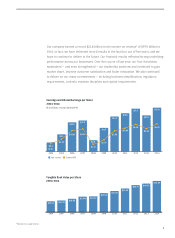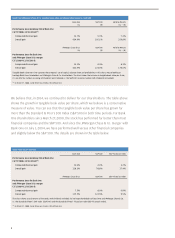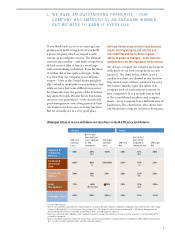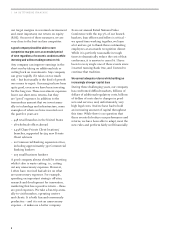JP Morgan Chase 2014 Annual Report Download - page 15
Download and view the complete annual report
Please find page 15 of the 2014 JP Morgan Chase annual report below. You can navigate through the pages in the report by either clicking on the pages listed below, or by using the keyword search tool below to find specific information within the annual report.
1313
I. AN OUTSTANDING FRANCHISE
bonds to assist municipalities and hospitals,
and green bonds to finance environmentally
beneficial projects such as green buildings,
clean water and renewable energy. As a firm,
we spend approximately $700 million a year
on research so that we can educate investors,
institutions and governments about econo-
mies, markets and companies. The needs of
these clients will be met – one way or another
– by large financial institutions that can bear
the costs and risks involved. Simply put, if
it is not done by a large American financial
institution, it will be done by a large non-
American financial institution.
Regional and community banks are critical
to their communities — in fact, we are a huge
supporter and their largest banking partner.
These banks are deeply embedded in their
communities, many of which are not served
by larger banks. They have an intimate
knowledge of the local economy and local
small businesses, which allows them to cost-
eectively serve those clients. JPMorgan
Chase, as a traditional “money center bank”
and “bankers’ bank,” in fact, is the largest
banker in America to regional and commu-
nity banks. We provide them with many
services so they can continue to serve their
clients. For example, we directly lend to
them, we process payments for them, we
finance some of their mortgage activities, we
raise capital for them (both debt and equity),
we advise them on acquisitions, and we buy
and sell securities for them. We also provide
them with interest rate swaps and foreign
exchange both for themselves – to help them
hedge some of their exposures – and for
their clients.
However, large does not necessarily mean
complex (and things should be complex only
for a good reason)
Many of the activities we do that are consid-
ered large are easy to understand. All of our
5,600 Chase consumer branches do essen-
tially the same thing, and many of our large
global transactions are not any more compli-
cated than a loan for a middle market client.
While we agree with the concept that you
should keep things as simple as possible,
some things, by their very nature, are more
complex. And that complexity cannot be
reduced by wishful thinking. In fact, basic
lending, whether to a large company or
a midsized company, is one of the more
complex things we do because one must
understand the economy, the nature of
the business and often the types of collat-
eral involved. There are many judgmental
factors to consider as well, which might
include the character of the borrower, the
growth prospects of the business, and an
understanding of the products and services
and technology of the business.
There are understandable questions about
the role that large financial institutions
play. Some of these questions make people
nervous, in part because they do not under-
stand the larger picture. These are important
questions, and we always are willing to help
explain what we do and why we do it. Taken
in small component pieces, these activities
generally are easier to understand. While
some may criticize a bank’s activities instead
of taking the time to understand them, this
does not contribute to a genuinely construc-
tive dialogue around the role of banks.
People also should ask themselves one
basic question: Why do banks oer these
services? The fact is, almost everything we
do is because clients want and need our
various and sometimes complex services.
(We do many activities that are ancillary to
clients’ direct needs, but we must do these
things to provide clients with what they
need. For example, in order to support our
operation, we run global data centers, we
hedge our own exposures and we maintain
liquid pools of investments.)
I would venture to say that banking is not
as complex as making airplanes, discovering
eective pharmaceuticals, building safe
cars, developing innovative electronics and,
of course, understanding nuclear physics.
There are huge benefits to the complexity
involved in those other industries – but there
also are sometimes negative consequences.
The question for society is: Are we, in total,
























